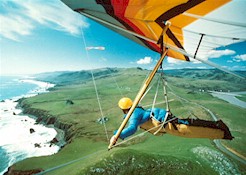WEEKEND OF HIGH ADVENTURE SKYDIVES
by Louis BignamiSky diving isn’t nearly as dangerous as, say, the LA Freeway on the night before a holiday. If it were that dangerous, none of the sky diving businesses would last more than a few days. Businesses must be insured, and insurance underwriters aren’t charitable.
Most of all sky diving is freedom. It’s incredibly thrilling at first, then awe and anticipation change to sheer delight as you discover its weightless delights. Some are satisfied with a single solo static line or tandem jump. Others move to the freedom of free-fall. Some specialize in target diving where you try to land in a specific spot.
As a weekend for a thrill seeker sky diving’s tough to beat. Blue Sky Adventures, out of Paso Robles conveniently midway between Los Angeles and San Francisco, runs one of the best programs in the state in an area where the winds are usually low and the surroundings pleasant. You’re a half hour from San Luis Obispo, San Simeon or the beaches.
Owner Dave Hughes was, after all the British Skydiving Champion in 1986. He takes a relaxes British attitude and an efficient approach that stresses safety with as automatic activation devices (A.A.D.)on free-fall rigs, special chutes and intensive training. You’ve got three choices.
The tandem program locks you into a rig with an instructor who handles details like the plane exit and landing. You enjoy, at least after the first rush, nearly a minute of free fall. Then the chute opens 4,000 feet above the ground to reduce what a buddy in the service calls, "the pucker factor." Landings are super soft under the extra large ram-air chute. Best of all, you can learn what you need to jump in about 30 minutes. Tandem jumps suits those who have little time, have physical problems or who are a bit timid.
Static line jumps the "Stand in the door, hook up, green light and go" approach used by the military automatically opens your chute as you exit the plane at 3,500 feet. A static line -- hence the name -- opens your chute and you steer yourself into the landing area with radio instructions from your instructor. The jump offers about five to six minutes air time. Since you’re basically dumped out of the plane like cargo you can learn basic air and landing skills in four or five hours. This is the usual first jump for beginners.
Accelerated Free Fall’s is a safe and effective method to get you into free-fall fast and a major shortcut to skydiving. You learn individually or in a small group -- expect five to six hours time -- so you don’t forget basics like body position before your chute opens and, or course, pulling the rip cord. Then, when you pile out of the plane two instructors dive with you. They help with your body position, correct any spins and offer reassuring grins as needed. Then you pull the rip cord -- the A.A.D. device and the instructors are there as backup -- and, with radio help, glide your chute down from about 4,500 feet. A few of these and you’re ready to go on your own.
All three of these approaches come with video and still photos if you like so you can replay the thrills and chills later. What a killer birthday or anniversary present even for those who find it a "one time only" thrill. It’s a trip!
Blue Sky Adventures 805-239-3483 Note: ask about group rates
